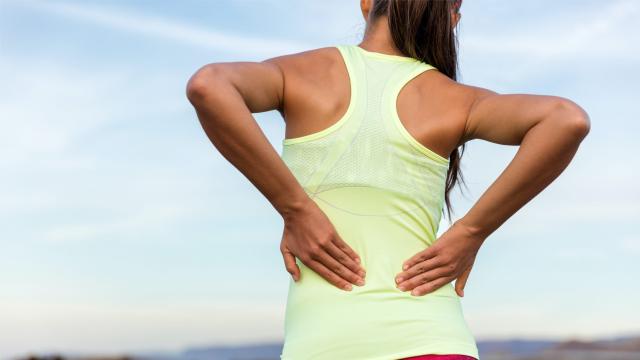It’s normal to feel sore after your first day of a new workout, but maybe you’ve heard horror stories of people who ended up in the hospital after they destroyed themselves with a super intense workout. Chances are, your soreness is normal, but here’s how to know.
What normal soreness feels like
DOMS, or delayed onset muscle soreness, usually shows up the day after a hard workout. The more severe it is, the longer it will last, often peaking 48 to 72 hours after the workout. A mild case will just leave you feeling mildly sore for a day or two; a rougher one might have you wincing when you walk down stairs for most of a week.
The feeling can range from a dull ache to a burning pain. It will feel the most uncomfortable when you’re contracting the sore muscle, especially if you’ve been sitting still for a while. You might wake up thinking oh god, everything hurts, but once you get up and walk around, you’ll probably feel a bit better.
If you go back to the gym during this time — which you should! — you’ll find that you can still do the same exercises but might find that the soreness makes it harder to do them with as much weight or for as many reps as the first time around.
As a bonus, though, a bout of soreness protects you from getting sore the next time. It’s called the “delayed bout effect,” and you can take advantage of it by showing up to your next workout even if you’re not feeling totally back to normal. DOMS only crops up after new or extremely intense workouts, so once your body is used to a particular exercise, you won’t get a serious case of DOMS anytime soon.
What if it’s rhabdomyolysis?
There is an extreme type of muscle soreness that can cause serious health complications, and it’s called rhabdomyolysis, or “rhabdo” for short. In rhabdo, you have so much damage to your muscles that your body, and especially your kidneys, can’t handle the resulting metabolic waste products that end up in your bloodstream.
That said, it’s not very common. If you just did a new workout and you feel sore all over, it’s far more likely that you have a bad case of DOMS than that you have rhabdo. To give you an idea of how rare, this study found 29 cases over a period of four years (2010-2014) in one of New York City’s hospitals. Since it’s just one hospital, there must have been more cases in the city in those years than just 29; but on the other hand, that’s still a teeny tiny fraction of people who exercise.
But rhabdo does happen. And because it happens more frequently in absolute beginners who go too hard than in experienced athletes (who presumably know when to stop pushing themselves), you may be facing your first bout of extreme soreness and not knowing whether you’re unusually sore or not.
Who gets rhabdo
Exercise-induced rhabdo — which, again, is rare — is more likely to occur in people who:
-
Are dehydrated.
-
Exercise in extreme heat.
-
Do an extreme intensity or amount (or both) of exercise in one workout.
-
Are new to exercise and push themselves really hard.
-
Are taking certain medications, including ibuprofen or other NSAIDS.
Besides hard workouts, rhabdomyolysis can also occur as a complication from injuries that damage a lot of muscle tissue, and from some medications or other health conditions.
The symptoms to watch out for, according to the CDC, can happen anytime in the days following the workout and include:
- Severe muscle pain, weakness, and swelling.
- Dark urine (“tea- or cola-coloured”).
- Extreme fatigue.
If you have these symptoms, seek medical care right away, even if that means going to the emergency room or urgent care.
Once you’re there, a blood test can confirm whether you have rhabdo, and you can get the care you need to make sure you don’t end up with kidney damage or other serious problems. The CDC says to make sure you are getting tests for creatine kinase or creatine phosphokinase, ideally repeated over the course of hours or days.
What to do if you’re just sore
Besides making sure not to skip your next workout, we have a few tips for you. The bad news is that nothing will make DOMS go away; you have to recover. And to recover, you need sleep and food and time.
But while you’re waiting it out, a few things might help you feel better. Moving around helps, so go for a walk or consider a light cardio workout. Massage can feel good, so get someone to massage you or do some self-massage with a foam roller or a lacrosse ball.
Some people find stretching helps, but make sure not to stretch too hard, which can damage your muscles further. I like to take a hot bath or use a heating pad. (Driving in a car with heated seats is a delight after a workout that uses your back and hamstrings.)
And, as always, seek medical care for anything that feels particularly concerning. An article on the internet can’t tell you whether you’re seriously injured or just a little sore, but an actual doctor can.

Leave a Reply
You must be logged in to post a comment.